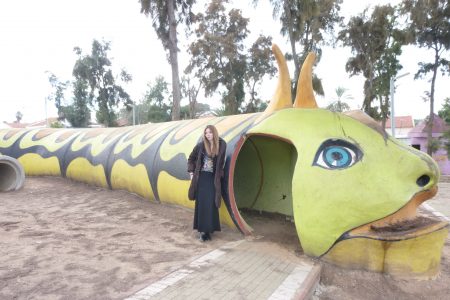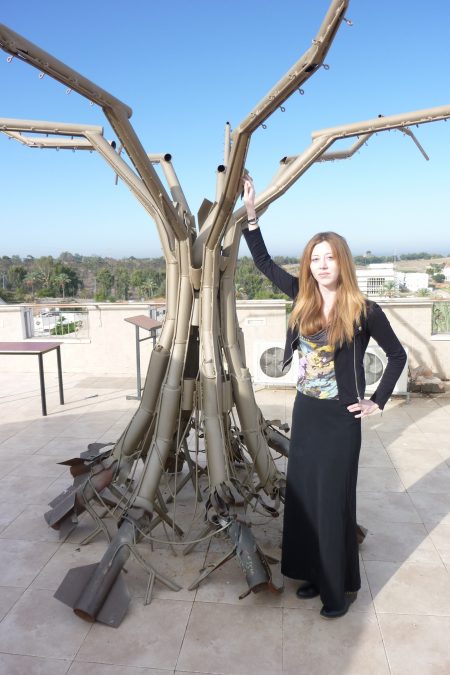

Makeshift bomb shelter in Nitzan, Southern Israel, temporary home for several hundred residents who had been evacuated from Gush Katif
What does security look like on the ground and up close? It is far more intricately woven and much more nuanced than what mass media could possibly convey, or is willing to convey.
As an American-born analyst working in the Israeli security field, I’m used to getting the macro-analytical view of such contentious issues in the country. More recently, I have been involved in projects regarding public diplomacy, media relations, and security issues in Israel. Which is exactly why on the heels of Operation Pillar of Defense, I was eager for an opportunity to take an interactive tour of the area and see with my own eyes what was happening amongst the civilian populations on the ground.
“Right and left wing labels and slogans just don’t cut it when it comes to talking about Israel,†explains Chaim Landau, the director of Perspectives Israel. “Dealing effectively and constructively with the conflict requires a deep and nuanced understanding of the intricate human mosaic surrounding the conflict. Perspectives gives its participants the opportunity to better understand and appreciate the multiple narratives and viewpoints that exist within the Jewish–Israeli spectrum.â€
The two-day Perspectives Israel tour certainly provided a vast array of narratives: a Zionist haredi woman in Bayit V’Gan whose husband rose to fame in the Knesset, a former diplomat who deserted the government in protest and joined Peace Radio Station in East Jerusalem, the Israel Defense Forces’ (IDF) architect of the security barrier, former residents of Gush Katif living in temporary caravans in Nitzan now under Hamas rocket fire, local peace activists who had been evacuated from Yamit and are now trying to start a dialogue with the Palestinians from Gaza, and at-risk youth employed at a café in Sderot. We slept over in Kibbutz Dorot, rising early the next morning to get a “slice of life†from the residents of Sderot, a brief survey of Gaza City from the edge of the security fence, ending the tour with a presentation by a panel of religious and secular settlers in Gush Etzion.
The State of Israel has a rich story to tell, but the Palestinian narrative dominates the media. In the latest outbreak of conflict with Hamas, the suffering on the Palestinian side was well-documented and replete with dramatic photographs splashed across foreign press outlets, while the suffering on the Israeli side was almost completely ignored. The fact that Israel is a dynamic first-world country with a superior military is not an excuse to pooh-pooh the distress that Israeli civilians are experiencing, not to mention the internal conflicts that the Jewish people are struggling with in the face of this ongoing conflict.
As Landau points out, “The recent discourse on Israel has turned destructive in Jewish communities across the globe. It’s time to shift the conversation. [Perspectives Israel] enables a new conversation by focusing on the issues and especially the people whose lives are entwined with the conflict.â€
A perfect example of this manipulation of narrative is the security barrier, built to protect the Israeli civilian population against the onslaught of suicide bombings during the Palestinian uprising. From a security perspective, the barrier has been considered highly successful, due to the fact that since the construction of the fence suicide attacks against Israeli civilians declined by 90%. At the same time, Israel has endured harsh political criticism claiming that the “Apartheid Wall† infringes upon Palestinians’ human rights.
Which is why a ground-level tour with Danny Tirza, who the Arabs refer to as “Abu Hareida†(“Father of the Mapâ€), is a good experience if you want to get your facts straight. As the former head of regional strategic planning in the IDF, a lesson on spokesmanship can also be learned from Tirza: he was friendly, straightforward, informative, able to give over complicated information in a compact fashion, and willing to answer pointed questions by the participants in an undefensive manner. He showed that rather than a haphazard “land grabâ€, in drawing the line of the barrier the humanitarian concerns regarding Palestinian civilians were carefully assessed in the Supreme Court, ensuring not a single Palestinian home was destroyed and providing access from one side of the fence to another. It’s one thing to hear the claims in the news – it’s another to see the civilian terminals and other built-in features for yourself.
Hundreds of photographs of Palestinian children standing in front of the “Apartheid Wall†used by pro-Palestinian activists tells only a miniscule part of the story – literally. Out of the 726 total kilometers of the security barrier, only 5% of it is actually a wall. The vast majority of the barrier is a fence loaded with sensors and cameras to alert the IDF to infiltrators. What activists cry as “unethicalâ€Â has in reality saved countless casualties on both sides of the conflict.
The southern city of Sderot, located less than a mile from the border with Gaza, is another example of bold Israeli defense measures woven into everyday civilian life. Not to make light of the situation, but Sderot is like the Bubba Gump shrimp of rocket-proofing: I’m talking rocket-proof children’s parks, rocket-proof yeshivas and libraries, a rocket-proof shelter at every bus stop. You name it.
The Israeli security community has invested over 1 billion shekels to protect its citizens in the south. Even with all these defense measures in place, it is a harrowing experience for an entire community to be forced underground every time the air-raid siren goes off, giving residents between 15 to 30 seconds to make a run for it. (What do you do when you’re giving your babies a bath and the sirens go off? One resident explained, “You just throw your body on top of your children and pray.â€) There are now an estimated 15,000 Israeli citizens suffering from Post-Traumatic Stress Disorder – how do you take a heartfelt photograph of PTSD to present as a prize to the media?
As Danny Tirza pointed out, “The aim of terror is not to kill people, but to make their lives unbearable.â€
In a nearby Israeli village called Netiv Ha’asara, the conflict is approached from yet another angle. Peace activist and former Yamit resident Roni Keidar told personal stories of her family’s interaction with Arab neighbors during times of tension, as well as described the activities of her grassroots organization “Other Voiceâ€. According to the group’s perspective, “We live in a violent and unstable region, in which thousands of people from both sides of the border have been killed, wounded and hurt. The ongoing violence and escalation of the conflict have deepened the mutual fear and hatred, and destroyed feelings of personal safety.â€
As part of Keidar’s efforts to involve Palestinians in a creative action to bring about long-term cooperation, she regularly conducts dialogues and assists sick Palestinians provided with permits to be treated by hospitals inside Israel. She describes her response to one Palestinian who pointed towards Ashkelon and said his family used to have a house there:
“I know. My family used to have a beautiful home in Egypt. How can we make the best of this situation and move forward?â€
That last sentence can be said for what seems like irreconciable differences in the Jewish community. There are times to speak up, and there are times to just sit down and listen to each other. At the end of the presentation, Keidar summed up my experience of the entire tour when she stated, “You don’t have to accept the other side’s narrative, but you can try to understand it.â€
Although I found my value system coming into conflict with that of many of the speakers and participants (note: the tour is designed to be this way), I must say how impressed I am with the diversity, brains, and dedication that exists in Israel. Even if I don’t agree with someone’s religious or political viewpoint, even if as a security professional it’s difficult to listen to people who seem unfairly critical of the country, I’m really proud of this spark in the Jewish people that demands justice, that fights to protect the vulnerable, and that is stubborn enough to keep plugging away no matter what conflict we’re facing.
We are a complex, dynamic country and we have a great story to tell. For anyone who doesn’t believe it, go sign up for a trip and see Israel up close for yourself.
- A Recipe for Leadership: Visions from Jerusalem’s Presidential Conference 2013 - 6/21/2013
- Security on the Ground: A Perspectives Tour - 12/5/2012
- A Carefully Calibrated Attack - 11/15/2012










When Jessica Snapper has visited the other side of the Israeli/Palestinian conflict – without the obvious pro-Israeli viewpoint in this article – she might elicit some sympthy for the issues in this insane conflict. First and foremost is that Jessica must go back to the creation of Israel and recognize that it was created from Palestinina lands – not Israeli lands. She might then begin to understand the nature of the conflict.